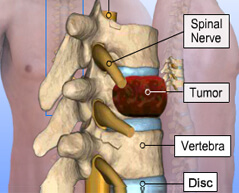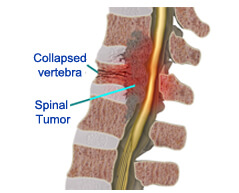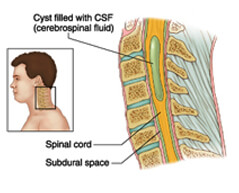Spinal Cord Tumor
 All the functions and senses of the body are controlled by the nervous system. This system is made up of the brain, spinal cord and a network of peripheral nerves that spread throughout the body from the spinal cord. The brain and spinal cord are known as the central nervous system (CNS).
All the functions and senses of the body are controlled by the nervous system. This system is made up of the brain, spinal cord and a network of peripheral nerves that spread throughout the body from the spinal cord. The brain and spinal cord are known as the central nervous system (CNS).
The spinal cord stretches from the base of the brain down, inside the bones of the backbone, which is also known as the spine or the spinal column. The spinal cord doesn't reach the full length of the spine but ends in the small of the back (the lumbar area).
The spinal cord is surrounded and protected by the backbone. The backbone is made up of bones called vertebrae. The peripheral nerves spread out from between these vertebrae.
There are 26 vertebrae in the spine:
- 7 cervical (neck)
- 12 thoracic (chest area)
- 5 lumbar (lower back)
- The sacrum (pelvic area) and the coccyx (tail bone).
- The sacrum and the coccyx are made up of a number of bones, which are joined or fused together. There are five bones in the sacrum and four in the coccyx.
- The meninges and cerebrospinal fluid (CSF) also surround and protect the brain and spinal cord. The meninges are membranes made up of three layers: dura mater (outer layer), arachnoid mater (middle) and pia mater (inner).

Planning your medical trip to India is a very simple process with Spine and Neuro Surgery Hospital India
- You just need to fill in our enquiry form and one of our executive will contact you soon.
- +91-9325887033 Call us at the given to contact number for any assistance.
- Complete information regarding surgery is provided on our website.
The spinal cord provides communication between the brain and the rest of the body. For example, if we want to pick something up, the brain sends an impulse down the spinal cord and along the nerves that control the functions of the hand.
Nerve impulses can travel up or down the spinal cord. If the object we pick up is soft to touch, an impulse travels up the spinal cord to the brain and tells us the object has a pleasant feeling. These are known as motor and sensory impulses.
Cells within the CNS normally divide and grow in an orderly and controlled way. But if, for some reason, this process gets out of control, the cells keep dividing and form a lump or tumour.
Tumours are either benign or malignant. A benign tumour (not cancerous) can keep growing but cannot spread anywhere else in the body. In a malignant tumour (cancerous), the cells can grow into and destroy surrounding tissue. The cancer cells may spread to other parts of the CNS. Tumours affecting the CNS are rare.
Intramedullary tumours
These are found within the nerves of the spinal cord. There are several different types of cancer of the spinal cord, but the most common are astrocytomas and ependymomas.
Intradural extramedullary tumours
These start inside the coverings of the spinal cord, but outside the cord itself. Meningiomas and nerve-sheath tumours, such as schwannomas, are the most common types of intradural extramedullary tumours.
Extradural spinal tumours
 Some tumours start in the bones of the spine. These are primary bone tumours and there are several different types. Benign tumours include osteomas and osteoblastomas. Malignant tumours include osteosarcomas, chondrosarcomas, chordomas and fibrosarcomas.
Some tumours start in the bones of the spine. These are primary bone tumours and there are several different types. Benign tumours include osteomas and osteoblastomas. Malignant tumours include osteosarcomas, chondrosarcomas, chordomas and fibrosarcomas.
Secondary bone cancers
Some cancers can spread into the bones of the spine (vertebrae) from elsewhere in the body. These are known as secondary bone cancers. The most common primary cancers to spread to the vertebrae include lymphoma, lung, breast and prostate cancer. Myeloma is a cancer of the plasma cells, which commonly affects the vertebrae. This section does not cover secondary cancer of the spine or myeloma.
What causes tumours that start in the spinal cord or the membranes (meninges) covering the spinal cord is not known. Research is being done to find possible causes.
Signs and symptoms of spinal cord tumours
These depend on the position of the tumour in the spinal cord. Spinal tumours often cause symptoms by pressing on the spinal nerves. Common symptoms include back and neck pain, numbness, and tingling and weakness in the arms or legs, or both.
Other symptoms can be clumsiness and difficulty walking. Tumours in the lower part of the spinal cord may cause loss of bladder and bowel control (incontinence).
Tests and investigations for spinal cord tumours
Your doctors need to find out as much as possible about the type, position and size of the tumour, so they can plan your treatment. You may have a number of tests and investigations.
CT (computerised tomography) scan
A CT scan takes a series of x-rays which build up a three-dimensional picture of the inside of the body. The scan is painless and takes 10-30 minutes. It uses a small amount of radiation, which is very unlikely to harm you or anyone you come into contact with.
You will be given an injection of a dye, which allows particular areas to be seen more clearly. This may make you feel hot all over for a few minutes. It's important to let your doctor know if you're allergic to iodine or have asthma, because you could have a more serious reaction to the injection.
MRI (magnetic resonance imaging) scan
This test is similar to a CT scan but uses magnetism instead of x-rays. It builds up a detailed picture of areas of your body. Before the scan, you may be asked to complete and sign a checklist to make sure it's safe for you.
Before the scan, you'll be asked to remove any metal belongings, including jewellery. Some people are given an injection of dye into a vein in the arm. This is called a contrast medium and can help the images from the scan to show up more clearly. During the test you will be asked to lie very still on a couch inside a long cylinder (tube), for about 30 minutes. It's painless but can be slightly uncomfortable, and some people feel a bit claustrophobic. It's also noisy, but you'll be given earplugs or headphones.
Treatment for a spinal cord tumour
The treatment for a spinal tumour depends on a number of things including your age and general health, along with the position, size and type of the tumour. The results of your tests will enable your doctor to decide on the best treatment for you. There are some risks associated with treatment to the spine and your doctor will discuss these with you.
Before you have any treatment, your doctor will tell you what it involves and explain its aims. They will ask you to sign a form saying that you give permission (consent) for the hospital staff to give you the treatment.
 Treatment can be given for different reasons and the potential benefits will vary for each person. If you've been offered treatment that aims to cure your cancer, deciding whether to have the treatment may not be difficult. However, if a cure is not possible and the treatment is to control the cancer for a period of time,
You can always ask for more time if you feel that you can't make a decision when your treatment is first explained to you.
Treatment can be given for different reasons and the potential benefits will vary for each person. If you've been offered treatment that aims to cure your cancer, deciding whether to have the treatment may not be difficult. However, if a cure is not possible and the treatment is to control the cancer for a period of time,
You can always ask for more time if you feel that you can't make a decision when your treatment is first explained to you.
You are also free to choose not to have the treatment. The staff can explain what may happen if you don't have it. You don't have to give a reason for not wanting treatment, but it can be helpful to let the staff know your concerns so they can give you the best advice.
Surgery
The aim of the surgery is to remove the tumour without weakening the spine. Sometimes it's possible to remove spinal cord tumours completely, especially if the tumour is on the outer part of the spinal cord. If the tumour cannot be removed completely, it's often possible to remove part of it. This can help slow down the progress of the tumour.
A type of surgery called decompressive laminectomy is sometimes done to relieve pressure within the spinal canal. The spinal canal is the opening in the vertebrae which the spinal cord runs through. Parts of several vertebrae and some of the tumour are removed. As well as relieving pressure, this enables samples of cells from the tumour to be taken (biopsy), to find out which type of tumour it is.
Radiotherapy
Radiotherapy uses high-energy rays to destroy the cancer cells, while doing as little harm as possible to normal cells.
It's usually given by directing radiotherapy rays at the tumour from outside the body. This is called external radiotherapy. It's used to treat spinal tumours that have not been completely removed with surgery or if the tumour comes back after initial treatment. Sometimes radiotherapy is used as the main treatment when surgery isn't possible. Radiotherapy can also be used to relieve symptoms, such as pain.
Steroids
Steroids are chemicals naturally produced in the body. They are made by the reproductive organs and the adrenal glands above the kidney. They help control and regulate how the body works. Steroids can be given as tablets or by injection.
They can reduce the swelling that often surrounds spinal tumours. Although steroids do not treat the tumour itself, they are very useful in improving symptoms and making you feel better. They may be used before or after surgery, or before, during or after radiotherapy.
Chemotherapy
Chemotherapy is the use of anti-cancer (cytotoxic) drugs to destroy cancer cells. Chemotherapy is occasionally used for certain types of spinal tumours. Research is looking at ways of developing this type of treatment.
Secondary spinal cord tumours
It's rare for a cancer elsewhere in the body to spread into the spinal cord, but this may occasionally happen. The treatment used in this situation will depend on where in the body the primary cancer started. This is because secondary tumours respond to the same treatment as the primary tumour that they developed from.
Sometimes when a secondary cancer is affecting the spinal cord, it can put pressure on the spinal cord and nerves. This can affect the function of the nerves. In this situation, treatment needs to be given as soon as possible. Treatment will usually include steroids and radiotherapy (or occasionally surgery). The aim of the treatment is to shrink the tumour and relieve pressure on the nerves. Once the pressure is relieved, further treatment may be needed. This depends on the site of the primary tumour, which the secondary tumour came from.
Hospitals such as hospital in Nagpur provide specialized treatment for Spinal Cord Tumor. The cost of surgery is comparatively quite low in Spine and Neuro Surgery Hospital.
Get Low Cost Spinal Cord Tumor Treatment in India
We offer free assistance to international patients to find best medical treatment in India. We offer low-cost, world-class medical treatment in India, coordinated by a team of experienced service industry professionals
Please post a query to know about low cost treatment options at top India hospitals
Click Here
